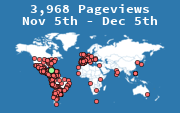Síndrome de Klein-Waardenburg: presentación de una familia
Palabras clave:
Síndrome de Klein-Waardenburg, iris, sorderaResumen
Se reporta la presencia de una familia portadora del síndrome de Klein-Waardemburg en el municipio de Artemisa existiendo varios miembros afectados con diversos grados de expresividad en las tres últimas generaciones de esta enfermedad infrecuente, autonómica dominante que cursa con cierto grado de discapacidad cuando aparece la hipoacusianeurosensorial. No se pudo clasificar a los enfermos según las variantes del Síndrome, pues los mismos carecían de estudios genéticos. Se expone además una revisión bibliográfica de los aspectos genéticos que dan lugar a la aparición del síndrome.
Descargas
Citas
Sindrome de Waardenburg. Descriptores en Ciencias de la Salud [Sitio de Internet]. Disponible en: http://www.bireme.br [Acceso: 14 dic. 2003]
Thompson U, MC Innes R, Willard H. Genética en medicina. 4 ed. NewYork: Masson; 1996.
Álvarez Sintes R. Temas de medicina general integral. La Habana: Ciencias Médicas; 2001; T 2. cap 7, p 465.
Schaffer AJ, Avery ME. Enfermedades del recién nacido. La Habana: Pueblo y Educación; 1980; T 2.
Bondurand N, Pingault V, Goerich DE, Lemort N, Sock E, Caignec CL, et al. Interaction among SOX10, PAX3, and MITF three genes altered in Waardemburg Syndrome. Hum Mol Genet 2000; 9(13):1907-17.
Sánchez-Martín M, Rodríguez García A, Pérez Losada J, Sagrera A, Read AP, Sánchez García I. SLUG (SNA12) deletions in patients whith Waardemburg disease. Hum Mol Genet 2002; 11(25):3231-6
Sotirova BN, Rezaie TM, Khoshsorour MN, Sarfarazi M. Identification of a novel mutation in the paired domain of PAX3 in an Iranian family whith WS type 1. Ophthalmic genet 2000; 21 (1):25-8.
Marcova TG, Megrelishuilli SM, Shevtsov SP, Shuarts EL Clinical and molecular genetic investigation of Waardemburg syndrome type 1. Vestn Otorinolaringol. 2003 ;(1):17-9.
Lalwani AK, Attaie A, Rendolph FT, Doebmukh D, Wang C, Mhatre A, et al. Point mutation in the mitf gene causing Waardemburg syndrome type 2 in a three generation Indian family. Am J Med Genet 1998; 80(4):406-9.
Tekin M, Bodurtha JN, Nance Ne, Pandya A. Waardemburg syndrome type 3 (Klein- Waardemburg Síndrome) segregating with a heterozygous deletion in the pairet box domain of PAX3 a simple variant or a true syndrome?. Clyn genet 2001; 60(4):301-4.
Jacquemin P, Lanncy VJ, O´Sullivan J, Read A, Lemaigre FP, Rousseau GG. The transcription factor onecut-2 controls the microphthalmia-associated transcription factor gene. Biochem Bioplys Res Comun 2001; 285(5):1200-5.
Selicorni A, Guerneri S, Ratti A, Pizzuti A. Cytogenetic mapping of a novel locus for type II Waardemburg syndrome. Hum Genet 2002; 110(1):64-7.
Takeda K, Takemoto C, Kobayashi I, Watanabe A, Nobukni Y, Fisher DE, et al. Ser 298 of MITF, a mutation site in Waardemburg syndrome type 2, is a phosphorilation site, with functional significance. Hum Mol Genet 2000; 9(1):125-32.
Verastegui C, Bille K, Ortorne JP, Ballotti R. Regulation of the Microphthalmia – associated transcription factor gene by the Waardemburg syndrome type 4 Gene, SOX10. J Biol Chem 2000; 275 (40):3757-69.
Touraine RL, Altie-Bitch T, Manceau E, Korsch E, Sarda P, Pingault V. Neurological phenotype in Waardemburg syndrome type 4 correlates with novel SOX10 truncatin mutations and expression in developin brain. Am J Hum Genet 2000; 66(5):1496-503.
Syrris P, Carter ND, Patton MA. Novel nonsense mutation of the endothelin-beta receptor gene in a family with Waardemburg-Hirschsprung disease. Am J Med Genet 1999; 87 (1):69-71.
Inobe K, Shilo K, Boerkoel CF, Crowe C, Sawady J, Lupski JR, et al. Congenital hypomyelinating neuropathy central dysmyelination and Waardemburg-Hirschprung disease: phenotype linked by SOX10 mutation. Ann Neurol 2002; 52(6):836-42.
Potterf SB, Furumura M, Dunn KJ, Arnheiter H, Pavan WJ. Transcription factor hierarchy in Waardemburg syndrome. regulation of MITF expression by SOX10 and PAX3. Hum Genet 2000; 107(1):1-6
Asher JH, Morrell R, Friedman TB. Waardemburg Syndrome (N.S). The Analysis of a single family Nith WS Mutation Shewing linkage to RFLP Markers en human chromosome 2q. AM J Hum Genet 1991; 48:43-52.
Tachibana M. A cascade of genes related to Waardemburg syndrome. J Investig Dermatol Symp Proc 1999; 4(2):126-9.
Fanareff A, Martín R, Merkat B. Enfermedades del feto y del recién nacido La Habana: Pueblo y Educación; 1985. 2 T.
Grundfast KM, San Agustín TB. Finding the gene (s) fer Waardemburg Syndrome Otorrhinolaringol. Clin Med North Am 1992; 25:935-51.
Salan GE. Introducción e incidencia relativa de los diferentes tipos de sordera neurosensorial. [Sitio de Internet] Disponible en: http://www.terra/sind.w aardemburg.com. [Acceso: 16 oct. 2003]
Black FO, PeszneckerSC, Allen K, Gianna C. A vestibular phenotype for Waardemburg syndrome?. Otol Neurotol 2001; 22(2):188-94.
Ministerio de Trabajo y Seguridad Social. Programa nacional de atención a personas sordociegas. La Habana: MINTAS; 2000.
Vergara MD, Sierra MM, Sandoval GJ, Vason MD, García GM. Síndrome de Waardemburg: presentación de un caso y revisión de los diferentes tipos.
BolMetHospInfantMex 1999; 56(12):666-6.
Aalfs CM, Smets EM, Haes JC de, Leschot MJ. Prenatal genetic coonseling in pregnancy: the importance of (early) timely referral. Met Tigdschr Geneeskd 2001; 145(33):1577-81.














